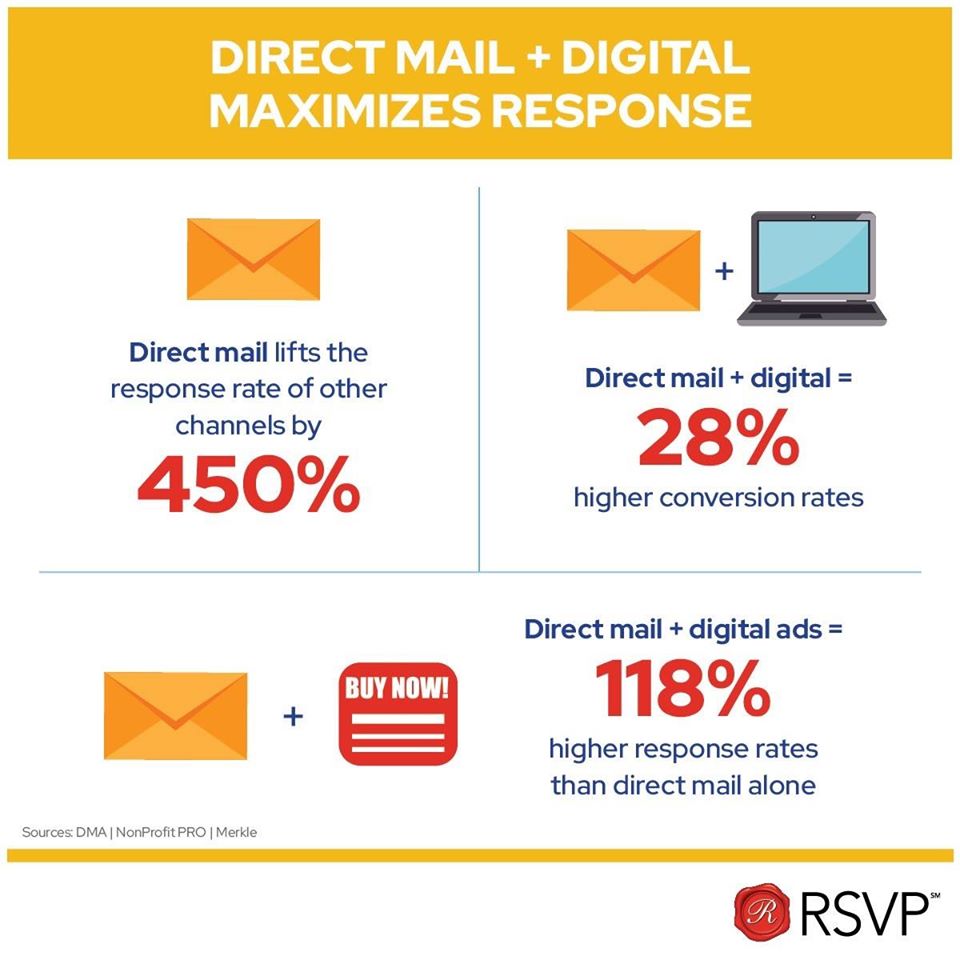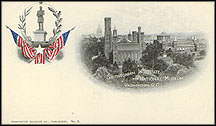Direct mail commands attention and cuts through the clutter – especially now when people are spending more time at home. See how you can outshine the competition with our Luxury Card Packs.
https://www.rsvpupscaleoffers.com/advertise/products

Direct mail commands attention and cuts through the clutter – especially now when people are spending more time at home. See how you can outshine the competition with our Luxury Card Packs.
https://www.rsvpupscaleoffers.com/advertise/products

We’ve crunched the numbers: combining direct mail and digital maximizes responses. Discover how RSVP can help you stand out to potential customers today!
https://www.rsvpupscaleoffers.com/advertise/products

Politican season is in full swing. How are you planning your content strategy & media mix to stand out among the political ads?

Marketing has been transformed by social media over the last few years and many businesses are now making digital solutions a large part of their strategy. However, digital solutions can only go so far with your potential clients. Thankfully, some traditional marketing tools, like direct mail, can still provide massive exposure.
Here are just a few ways why combining traditional marketing options with your digital strategy can make it more successful.
Just because our eyes spend hours looking at a screen every day doesn’t mean it’s the ideal form of communication. Studies show that people require 21% less brainpower to read a page of print than a page of online text and can recall the name of the business 75% better when printed.
When crafting your marketing strategy and combining direct mail and digital marketing, the digital strategy can give you quantity and greater reach, but print offers quality and staying power.
The problem with digital advertising is that while you are able to reach a wide selection of potential clients with one message, you are only one message in a full inbox. Unless you have an eye-catching subject line, the odds are high that you can get lost in the system.
With real mail advertising, you’ll instantly stand out in the eyes of the recipient in a much smaller pool of daily mail. The best part? You’ll also pop back into your recipient’s minds every time they see your flyer on their coffee table or fridge, giving your marketing strategy greater longevity.
Whether it’s the physical presence of the ad or the way we carry it around with us, there’s something tactile about a direct mail flyer that no amount of paid online ads or SMS deals can ever compete with.
One of the best ways you can take advantage of this is to change the gloss or texture of your flyer and customize it to stand out against the rest of the envelopes in a person’s mailbox. You can even include valuable gift cards in your marketing to further entice and attract your clients!
Marketing today requires a complex strategy to merge the real and digital worlds and keep your clients hooked. If you’re looking for proven ways to stay in your clients’ minds and consistently promote your business, give the staff at RSVP Upscale Offers a call today at 888-958-7787 or visit us online to see our wide selection of direct mail marketing options.
In print advertising, artwork is the initial impression that consumers have of your business or product. It’s the first step in gaining the attention of the buyer you are trying to sell to. That visual typically is the difference between if the person decides to pay attention to the pieces of your advertising- the verbiage, the product or service itself, and the offer, or moves along to what captures their attention next.
Almost every day I have conversations with business owners and decision makers who ask about how their artwork should look. It’s an important question and comes up so often because many people just aren’t sure how to go about it. Most people (including me) know what they like when they see it but don’t know how to express that verbally or artistically. That’s ok though, and the reason why my company employs very talented and artistic designers. I trust them implicitly because they’ve proven their professionalism with our clients consistently through the years. And they’re not just artists, they know what works and what consumers like.
With that being said, I have learned from many years of experience the difference between good and bad artwork:
Good
– Simple clear message
– Holds interest
– Stong call to action
Bad
– Requires the reader to work hard
– Missing attention-getting elements
– Can’t tell what you are really trying to offer
Ugly
– Full of clutter
– Low-quality images
– Overuse of color and fonts
(Graphic Designers nightmare)
Avoid the temptation to include every product or service line you offer in your ad. Don’t make the prospect have to think about or evaluate everything and the kitchen sink you threw in there. They don’t want to think and they’ll ultimately move past your ad and forget all about you. Tell your prospect we are Acme Company, we make your life better, and do it for 40% off. That’s it.
If you’re worried about leaving out something you think might be important then include your website address. If the prospect wants or needs more information they will gladly take the time to visit your website and learn more about everything you do and why it’s important to them. Your website is your encyclopedia, your print advertisement is not.

Contributed by Jeff Vice
noun \ˈpōs(t)-ˌkärd\: a card on which a message may be sent by mail without an envelope and that often has a picture on one side
The United States Postal Service first began issuing pre-stamped postal cards in 1873. They were introduced to the public as an easy way to send quick notes. Until May 19, 1898 the USPS was the only establishment allowed to print postcards. The monopoly ended when Congress passed the Private Mailing Card Act which allowed private publishers and printers to produce and mail their own postcards.
Private Mailing Cards Period, 1898 – 1901:
During the Private Mailing Card period, messages were not allowed on the back of the card. The only area where notes from the sender were permitted was a small space on the front of the card. The postcards required a 1 cent stamp.


In December of 1901, the USPS issued Post Office Order Number 1447 which allowed the words “Post Card” to be on the card instead of the longer “Postal Mailing Card.” Messages were still not allowed on the back of the post cards during this period.
A major change took place on March 1, 1907 with the way the backs of postcards looked. The left side of the back of the card was now allowed to have message written in that space. The right side of the card was for the address.
Up until this period German printers dominated the market in postcard printing. With the start of World War I, postcards were supplied mostly by printers in the United States. During this period, printers saved ink by not printing to the edge of the card leaving the white border around the image.
As time went on, new printing processes were developed. During this period, postcards could be printed with high rag content, which gave them a look of being printed on linen or cloth. Bright colors were also introduced during this period.
This style of postcards first appeared in 1939. The Union Oil Company carried them in their western service stations. Production of the postcards slowed during World War II because of supply shortages, but after the war, this type of postcards dominated the market. The photochrome postcards are in color and are the closest to real photographs and are the ones most familiar to us today.
At RSVP we love the postcard (obviously!). It’s not just a nostalgic piece of every family vacation we ever took – it’s a modern, upscale advertising tool that has proven itself to be as diverse as the pictures on the front. Long live the postcard!
Contributed by Marcella Gillespie.
A quick thank you to our sources for this awesome information:
http://siarchives.si.edu/history/exhibits/postcard/postcard-history
http://en.wikipedia.org/wiki/Postcard
A Lesson from Goldilocks and the Three Bears…

As I have talked to business owners over the last 14 years who have adopted a do-it-yourself mentality to marketing their business, I have often heard, “My mailing campaign didn’t work!” What I often find from them is that they have done their own mailing campaign of 100 or 200 mailers of some type, to a list of prospective homeowners that they’ve narrowly targeted, based on the direction of a friend, family member, or “marketing expert” at their networking group. They’re surprised that they get no response, or one or two lukewarm prospects.
The reality is that zero, one or two responses from a mailing of say 200 homeowners, is not actually bad at all, it’s just not enough. How does that make any sense? In fact it’s quite excellent for a cold campaign at 1% response rate. The problem is expectations. One or two lead calls for a home improvement company is not enough to keep a sales staff gainfully employed, and cash flow healthy. 10 or 20 leads would be more like it – right? 50 qualified leads even better!
Most direct response fails I believe, because business owners find the least expensive Cost per Thousand Impressions (CPM) advertising vehicles and blast their message out to mailboxes attached to dwellings of all types. The result is lots of “activity” and a disproportionately low level of sales for the activity expended.
Worse yet, with all the sophisticated demographic, psychographic, and geographic targeting techniques – some businesses take the extreme opposite approach by disqualifying too many good prospects and focusing too narrowly on a list that has no chance of being successful, based on too many assumptions.
Well what if there was a way to target your entire population of qualified and select prospective homeowners (The Mass Affluent) and received full service marketing consulting and design based on years of experience and proven track record… and laser-focus that message into the home for one-tenth the cost of a postage stamp?
What I have found is that if we mail 1000 times the circulation of the earlier example, at one-tenth the cost, but mail that to the Mass Affluent Homeowners, we get the desired result our business owners are looking for. They get qualified leads, enough to be impressed, that close at a high percentage, and have a strong ticket average. The result is a strong Return on Investment (ROI) for the advertiser, with laser-focused effort, and a fraction of the sales staff!
More is not better, but too little is worse!
Contributed by Anthony R. Sucato,
Retired Engineer
President RSVP Publications of Indiana, Kentucky, and Ohio
“Direct Marketing to the Affluent”
What impact can goal setting have on your business and your life this year?
A year ago we tasked our staff with not only setting business goals but also share something at our first staff meeting of the year that they’re shooting for in their personal life. We followed the SMART formula: 
The goals were varied – some focused on weight loss, financial success, household projects, getting your first place, and even making and honoring time commitments with family. The experience of sharing weekly updates on progress has been eye-opening. To speak that goal out loud each week and be accountable to taking one step closer to that goal led many to accomplishing their mission.
For 2014 we introduced our “personal best boards.” It’s a simple two-sided acrylic picture frame. On the front are our business benchmarks and stretch goals. On the back is visual representation of our individual goals – usually a collage of related or motivational pictures.
I’m so proud on the progress of our team!!! Just four months into the year many have accomplished their first goal and had to create a new goal for 2014. We have a fitter, happier success focused staff. They encourage and praise one another, and even look for opportunities to help them accomplish their personal goals.
“If you want to be happy, set a goal that commands your thoughts, liberates your energy and inspires your hopes.” –Andrew Carnegie
Experts will tell you to speak your goal out loud like a mantra. Visualize yourself completing your goal and how you will feel. Walking a mile begins with putting 1 foot in front of the other…
Reaching the goal is a combination of small but important steps. Be honest with yourself. Are your goals written down? Are they just dreams or do they have deadlines? What actions are you taking today to make this your best year yet?
Contributed by Heather Craaybeek.